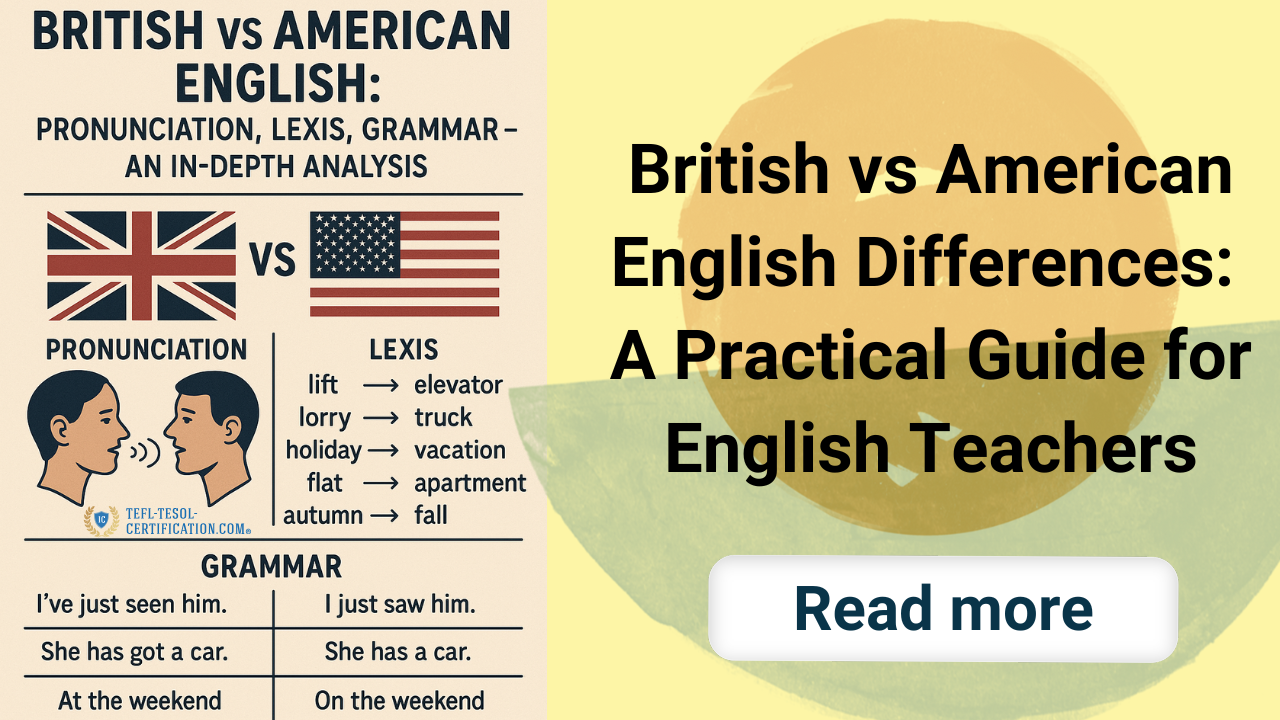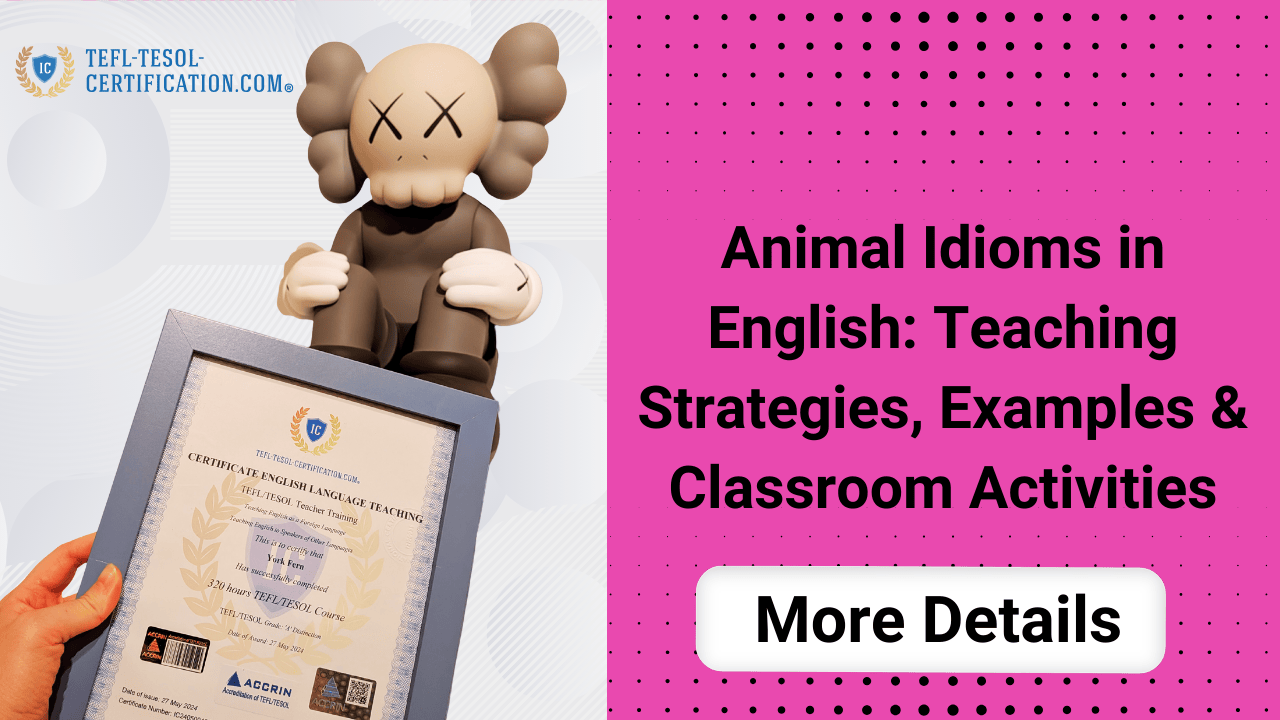And start earning money 💸 by teaching English in your own country, abroad, or online from anywhere on the planet! 🎁 Gifts and bonuses: professional support from your personal coach 🧑🏫 and job placement assistant 💼.
English learners often ask: “Which is correct — at the weekend or on the weekend?”, “Color or colour?”, “Did you get my mail or post?”, “Flat or apartment?”, “Is schedule pronounced /ˈʃedjuːl/ or /ˈskedʒuːl/?”
Questions like these turn into a ready-made lesson on British and American English differences. Below we unpack the most frequent classroom questions about pronunciation, vocabulary, and grammar, show why both varieties are valid in their own traditions, and outline how to decide which English to teach for different learner goals. 😊
British and American English: What Really Matters in Class
When students come with concrete contexts — relocation to the U.S., an internship in London, or a mixed international team — we need a clear prioritization. Treat the differences as three adjustable “dials”: pronunciation, vocabulary, and grammar. In class, establish a base variety first, then highlight contrasts.
- Pronunciation: phonemic contrasts (rhotic vs non-rhotic), rhythm, and vowel reduction.
- Vocabulary: everyday items, professional terminology, “false friends,” and frequency differences.
- Grammar: tense distribution, prepositions, agreement, and fixed expressions.
We’ll start with BrE vs AmE pronunciation, continue with British and American vocabulary, finish with American vs British grammar, and answer the question: Which English should students learn?
BrE vs AmE Pronunciation: A Sound Map for Teachers
From a phonology perspective, the differences are systematic. Keep a short in-class “marker list” so students can self-identify whether they’re hearing BrE or AmE.
- Rhoticity. Most American accents pronounce /r/ everywhere: car /kɑːr/. Standard British English often drops final /r/: /kɑː/. This shifts both timbre and vowel length.
- /t/-flapping. AmE butter ≈ [ˈbʌɾɚ]; BrE butter ≈ [ˈbʌtə].
- Yod-dropping. news, student, tune: BrE /njuːz, ˈstjuːdənt, tjuːn/ vs AmE /nuːz, ˈstuːdənt, tuːn/.
- Vowels. Typical pairs: cot–caught (often merged in AmE); bath /bɑːθ/ in BrE vs /bæθ/ in AmE.
- Lexical stress. advertisement — BrE /ədˈvɜːtɪsmənt/, AmE /ˌædvərˈtaɪzmənt/; garage — BrE /ˈɡærɑːʒ/, AmE /ɡəˈrɑːʒ/.
Training Pronunciation in Class
- Minimal pairs + shadowing in 60–90-second bursts.
- Marker cards for rhoticity, /t/-flap, yod-dropping — students tick what they hear.
- IPA policy: agree to use IPA transcriptions and show both variants in examples.
Two short rounds are usually enough for learners to hear the contrast. Then move to vocabulary.
British and American Vocabulary: 18 Word Pairs That Save a Lesson
Vocabulary is not only “truck vs lorry”; it’s also frequency, register, and cultural associations. Here’s a compact, printable table for notebooks. 🎯
| BrE | AmE |
| flat | apartment |
| lorry | truck |
| boot (car) | trunk |
| holiday | vacation |
| petrol | gas / gasoline |
| rubbish | garbage / trash |
| chemist | pharmacy / drugstore |
| queue | line |
| lift | elevator |
| football | soccer |
| crisps | chips |
| chips | fries |
| jumper | sweater |
| aubergine | eggplant |
| courgette | zucchini |
| postcode | zip code |
| car park | parking lot |
Classroom tips:
- Teach in themes. Food, transport, housing, documents — block learning supports retention.
- Mark register. drugstore is more colloquial; pharmacy is neutral.
- Flag false friends. pants = “trousers” in AmE but “underwear” in many BrE contexts.
Quick semantic check:
- — “I left it in the boot.”
- — “You mean the trunk? Same thing — different variety.”
American vs British Grammar: Systemic Differences and Teaching Notes
Grammar choices affect test performance and corporate style. Focus on six adjustable “knobs” in a modular course.
- Present Perfect vs Past Simple. BrE prefers I’ve just eaten; AmE commonly uses I just ate with just, already, yet. For exams, keep one variety throughout.
- Have (got). BrE: Have you got a minute?; AmE: Do you have a minute? Different auxiliary support in questions/negation.
- Past participles. AmE retains gotten (He has gotten better); BrE uses got.
- Collective nouns. The team are… (BrE, as individuals) vs The team is… (AmE, as a unit).
- Prepositions & fixed phrases. at the weekend (BrE) vs on the weekend (AmE); write to me (BrE) vs write me (AmE); Monday to Friday (BrE) vs Monday through Friday (AmE).
- Irregular verbs. learned/learnt, burned/burnt, dreamed/dreamt — AmE prefers -ed; BrE allows both depending on style.
Spelling and Punctuation: A Quick Reference
- -our / -or: colour vs color.
- -re / -er: centre vs center.
- -ise / -ize: both valid in BrE; AmE standardizes -ize.
- Double consonants: travelling (BrE) vs traveling (AmE).
- Different spellings: defence vs defense, programme (non-IT BrE) vs program, aluminium vs aluminum.
- Oxford comma: more common in AmE; in BrE it depends on the style guide.
- Dates: 12/03/2025 (AmE) vs 03/12/2025 (BrE). To avoid ambiguity, prefer 03 Dec 2025 or 2025-12-03.
Which English Should Learners Choose? A Practical Algorithm
The universal answer: choose a base standard but teach informed bilingualism within one course. That means one spelling system, one core lexicon, one set of phonetic rules — and the other variety presented as adjustable “settings”.
- Step 1 — Goals. Exams (IELTS/TOEFL), job market, relocation targets — let these drive the base choice.
- Step 2 — Group style guide. Create a course “passport”: e.g., “Base: BrE. AmE variants allowed and labeled.”
- Step 3 — Materials. Dual-accent audio, themed vocabulary sets, contrastive grammar tasks.
- Step 4 — Assessment. Writing follows the base; speech accepts both if clear and consistent.
Teacher’s Checklist: Keeping Focus in Class
- Meaning first. In speaking, accept either variety if the communicative goal is met.
- Form next. In writing, enforce the chosen standard: suffixes, quotation marks, date format.
- Awareness. Build noticing: short contrasts and margin notes.
- Consistency. One course — one base; exceptions must be marked and explained.
British and American Vocabulary: Memory Techniques
- Color-coding. Blue for BrE, green for AmE (or icons for B/W print).
- Scenario binding. Airport, supermarket, classroom — role-play scenes with vocabulary roles.
- Mini-stories. “I moved to a new apartment and took the elevator with two garbage bags…” — then rewrite in BrE.
BrE vs AmE Pronunciation: Quick Attention Tests
- Dictation with choice. Read six words; students mark BrE or AmE.
- Sound rail. Sticky notes for /t/-flap, rhoticity, /ɑː/ vs /æ/ — match to words.
- Closing circle. Each student shares one word they consciously switched.
Reinforce the system with contrastive homework plus one page from the vocabulary table.
💡 Unlock the secrets to doubling your teaching income with our exclusive checklist! 🎯 This checklist is designed for English teachers who want to 📈 attract more students and 🔥 keep them engaged for the long term.
Summary: Which English to Learn?
The right choice is the one aligned with the learner’s goals and environment. Operate on the principle: one base + mindful variation. This lowers anxiety, builds flexibility, and makes conversations — from Manchester to Austin — confident and precise. 🚀
TEFL and TESOL Course: Outcomes, Structure, and Who It’s For
A comprehensive TEFL/TESOL course equips new and experienced educators with practical, classroom-ready skills for international and online teaching. Typical programs span 120–320 study hours and cover phonology, lexis, grammar, lesson planning, classroom management, assessment, and inclusive practices for young learners and adults. You’ll build a professional portfolio (lesson plans, materials, reflections), complete knowledge checks and graded assignments, and may add an optional observed teaching practicum or micro-teaching labs. A dedicated module helps you choose and apply a consistent base variety (BrE or AmE) while training learners to switch intelligently between variants in pronunciation, spelling, vocabulary, and usage. By graduation, teachers can design clear, level-appropriate lessons, differentiate tasks, manage mixed-ability groups, and deliver confident, communicative classes across contexts and platforms.
What Commonly Breaks When Students Mix Varieties
- Spelling + lexis in one email. “I’ll organise the transportation for our centre.” — mixing -ise/-ize and -re/-er in one text.
- Tenses in reports. “We just finished the task.” — pick one: BrE (have just finished) or AmE (just finished), but don’t oscillate.
- Collective nouns. The staff are/is — decide per base standard and stick to it.
- Prepositions. on the weekend vs at the weekend — fix a template in the course guide.
What Exams and Workplaces Expect
- Writing: consistency above all. AmE requires color, center, program, and Do you have...? across the piece.
- Speaking: intelligibility and naturalness; both systems accepted if consistent within turns.
- Academic texts: follow the specified style (UK or US) where provided.
Corporate Email: Fast Consistency Checks
- Date format: use “03 Dec 2025” or ISO “2025-12-03”.
- Quotation marks: single (BrE) or double (AmE) — choose one and keep it.
- Verb variants: pre-decide learned vs learnt for reports.
Supporting This in a Skills Program
Build modules along three axes — phonetics, vocabulary, grammar — with contrastive activities. Keep the loop tight: theory → training → reflection → brief test.
American vs British Grammar: Extra Examples and Quick Wins
To make knowledge “stick,” give pairs of context → choice and ask learners to justify their choice out loud.
- Appointment set. The meeting is Monday (AmE) vs The meeting is on Monday (BrE). Choose per base for formal writing.
- Location. He’s in hospital (BrE, as a patient) vs He’s in the hospital (AmE/neutral).
- Messaging. Write to me (BrE) vs Write me (AmE).
“Friday After a Long Week” Mini Lesson
- 5 minutes — pronunciation: tune, news, water, car, garage.
- 7 minutes — vocabulary: airport scenes — BrE queue vs AmE line; BrE lorry vs AmE truck.
- 8 minutes — grammar: speed-debate cards “Have you got a...?” vs “Do you have a...?”.
British vs American English: A Decision Map for Instructors
- Make the base visible. Announce the standard in lesson one and note it on page one of notebooks.
- Collect a contrast bank. Per topic, keep 3–5 word pairs and 2–3 grammar contrasts.
- Teach register awareness. Label colloquial vs neutral items.
- Write to one guide. One written standard; receptive flexibility in speech.
- Track metrics. Each week, learners name three differences they applied in real tasks.
Extended Spelling Reference Table
| BrE | AmE | Note |
| colour | color | -our → -or |
| centre | center | -re → -er |
| organise/organize | organize | Both possible in BrE; AmE → -ize |
| travelling | traveling | Double consonant differences |
| defence | defense | -ce → -se |
| programme | program | IT uses “program” in BrE too |
| licence (n), practise (v) | license (n,v), practice (n) | Different distribution by part of speech |
Which English to Learn: A Straight Answer for Adults
If the student works with Europe or UK documentation, use a BrE base. If relocating to North America or taking TOEFL, use an AmE base. In all cases, teach learners to switch consciously and “hear” context — that’s a core 21st-century competence. 🎯
Need structure? Align your syllabus early: declare the base norm and how you will label alternatives. This resolves half the grading questions before they arise.
🚀 More students, 💰 higher income, 🌍 complete freedom! ✅ 112 verified platforms with top rates ⏳ Flexible schedule – work whenever and as much as you want 🎯 Simple requirements – start earning right away 💎 Boost your career and income by teaching students worldwide!
Homework That Actually Works
- Contrast dictation. 10 sentences — mark BrE/AmE and rewrite in the course base.
- Word list of the week. 12 pairs from the table — both varieties.
- Mini-essay. 120–150 words strictly in the base; add a note on forms consciously avoided.
Final Thought: Difference as a Tool, Not a Barrier
Knowing systematic differences between British and American English is professional hygiene for teachers. It streamlines international communication, improves exam prep, and makes marking consistent.
Choose a working standard (BrE or AmE) and codify it in your course policy. Practical steps:
- Announce the standard at the start. Pronunciation, spelling (color/colour), vocabulary (post/mail), grammar (at/on the weekend) should follow the chosen norm.
- Fix grading criteria. Allow the alternative norm only if the student uses it consistently.
- Unify materials. Slides, handouts, task templates, and answer keys should match one variety.
- Label dual norms. Show equivalents but mark “course standard” vs “alternative for comprehension”.
- Agree a house style for teams. If multiple instructors teach, share a common glossary and style sheet.
- Check external requirements. Where exams or employers specify a norm, follow it; otherwise keep your chosen standard.
Bottom line: choose the variety that fits the learning goal, announce it to students, and apply it consistently, while also training recognition and comprehension of the alternative forms. This ensures clear expectations, predictable feedback, and durable results.





